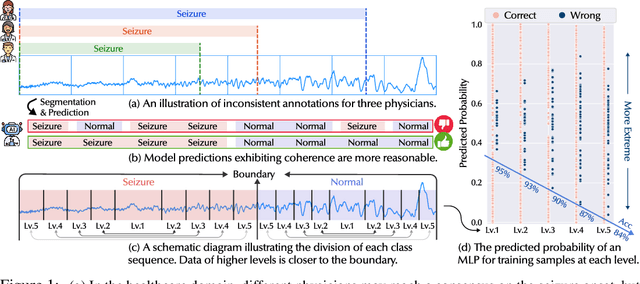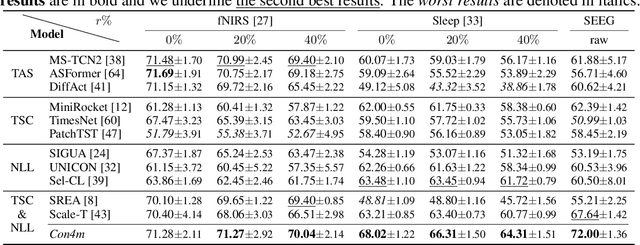Jiahe Li
Reinforcement Learning Optimization for Large-Scale Learning: An Efficient and User-Friendly Scaling Library
Jun 06, 2025Abstract:We introduce ROLL, an efficient, scalable, and user-friendly library designed for Reinforcement Learning Optimization for Large-scale Learning. ROLL caters to three primary user groups: tech pioneers aiming for cost-effective, fault-tolerant large-scale training, developers requiring flexible control over training workflows, and researchers seeking agile experimentation. ROLL is built upon several key modules to serve these user groups effectively. First, a single-controller architecture combined with an abstraction of the parallel worker simplifies the development of the training pipeline. Second, the parallel strategy and data transfer modules enable efficient and scalable training. Third, the rollout scheduler offers fine-grained management of each sample's lifecycle during the rollout stage. Fourth, the environment worker and reward worker support rapid and flexible experimentation with agentic RL algorithms and reward designs. Finally, AutoDeviceMapping allows users to assign resources to different models flexibly across various stages.
InsTaG: Learning Personalized 3D Talking Head from Few-Second Video
Feb 27, 2025



Abstract:Despite exhibiting impressive performance in synthesizing lifelike personalized 3D talking heads, prevailing methods based on radiance fields suffer from high demands for training data and time for each new identity. This paper introduces InsTaG, a 3D talking head synthesis framework that allows a fast learning of realistic personalized 3D talking head from few training data. Built upon a lightweight 3DGS person-specific synthesizer with universal motion priors, InsTaG achieves high-quality and fast adaptation while preserving high-level personalization and efficiency. As preparation, we first propose an Identity-Free Pre-training strategy that enables the pre-training of the person-specific model and encourages the collection of universal motion priors from long-video data corpus. To fully exploit the universal motion priors to learn an unseen new identity, we then present a Motion-Aligned Adaptation strategy to adaptively align the target head to the pre-trained field, and constrain a robust dynamic head structure under few training data. Experiments demonstrate our outstanding performance and efficiency under various data scenarios to render high-quality personalized talking heads.
Deep Learning-Powered Electrical Brain Signals Analysis: Advancing Neurological Diagnostics
Feb 24, 2025Abstract:Neurological disorders represent significant global health challenges, driving the advancement of brain signal analysis methods. Scalp electroencephalography (EEG) and intracranial electroencephalography (iEEG) are widely used to diagnose and monitor neurological conditions. However, dataset heterogeneity and task variations pose challenges in developing robust deep learning solutions. This review systematically examines recent advances in deep learning approaches for EEG/iEEG-based neurological diagnostics, focusing on applications across 7 neurological conditions using 46 datasets. We explore trends in data utilization, model design, and task-specific adaptations, highlighting the importance of pre-trained multi-task models for scalable, generalizable solutions. To advance research, we propose a standardized benchmark for evaluating models across diverse datasets to enhance reproducibility. This survey emphasizes how recent innovations can transform neurological diagnostics and enable the development of intelligent, adaptable healthcare solutions.
HOGSA: Bimanual Hand-Object Interaction Understanding with 3D Gaussian Splatting Based Data Augmentation
Jan 06, 2025



Abstract:Understanding of bimanual hand-object interaction plays an important role in robotics and virtual reality. However, due to significant occlusions between hands and object as well as the high degree-of-freedom motions, it is challenging to collect and annotate a high-quality, large-scale dataset, which prevents further improvement of bimanual hand-object interaction-related baselines. In this work, we propose a new 3D Gaussian Splatting based data augmentation framework for bimanual hand-object interaction, which is capable of augmenting existing dataset to large-scale photorealistic data with various hand-object pose and viewpoints. First, we use mesh-based 3DGS to model objects and hands, and to deal with the rendering blur problem due to multi-resolution input images used, we design a super-resolution module. Second, we extend the single hand grasping pose optimization module for the bimanual hand object to generate various poses of bimanual hand-object interaction, which can significantly expand the pose distribution of the dataset. Third, we conduct an analysis for the impact of different aspects of the proposed data augmentation on the understanding of the bimanual hand-object interaction. We perform our data augmentation on two benchmarks, H2O and Arctic, and verify that our method can improve the performance of the baselines.
Con4m: Context-aware Consistency Learning Framework for Segmented Time Series Classification
Jul 31, 2024



Abstract:Time Series Classification (TSC) encompasses two settings: classifying entire sequences or classifying segmented subsequences. The raw time series for segmented TSC usually contain Multiple classes with Varying Duration of each class (MVD). Therefore, the characteristics of MVD pose unique challenges for segmented TSC, yet have been largely overlooked by existing works. Specifically, there exists a natural temporal dependency between consecutive instances (segments) to be classified within MVD. However, mainstream TSC models rely on the assumption of independent and identically distributed (i.i.d.), focusing on independently modeling each segment. Additionally, annotators with varying expertise may provide inconsistent boundary labels, leading to unstable performance of noise-free TSC models. To address these challenges, we first formally demonstrate that valuable contextual information enhances the discriminative power of classification instances. Leveraging the contextual priors of MVD at both the data and label levels, we propose a novel consistency learning framework Con4m, which effectively utilizes contextual information more conducive to discriminating consecutive segments in segmented TSC tasks, while harmonizing inconsistent boundary labels for training. Extensive experiments across multiple datasets validate the effectiveness of Con4m in handling segmented TSC tasks on MVD.
CoR-GS: Sparse-View 3D Gaussian Splatting via Co-Regularization
May 20, 2024



Abstract:3D Gaussian Splatting (3DGS) creates a radiance field consisting of 3D Gaussians to represent a scene. With sparse training views, 3DGS easily suffers from overfitting, negatively impacting the reconstruction quality. This paper introduces a new co-regularization perspective for improving sparse-view 3DGS. When training two 3D Gaussian radiance fields with the same sparse views of a scene, we observe that the two radiance fields exhibit \textit{point disagreement} and \textit{rendering disagreement} that can unsupervisedly predict reconstruction quality, stemming from the sampling implementation in densification. We further quantify the point disagreement and rendering disagreement by evaluating the registration between Gaussians' point representations and calculating differences in their rendered pixels. The empirical study demonstrates the negative correlation between the two disagreements and accurate reconstruction, which allows us to identify inaccurate reconstruction without accessing ground-truth information. Based on the study, we propose CoR-GS, which identifies and suppresses inaccurate reconstruction based on the two disagreements: (\romannumeral1) Co-pruning considers Gaussians that exhibit high point disagreement in inaccurate positions and prunes them. (\romannumeral2) Pseudo-view co-regularization considers pixels that exhibit high rendering disagreement are inaccurately rendered and suppress the disagreement. Results on LLFF, Mip-NeRF360, DTU, and Blender demonstrate that CoR-GS effectively regularizes the scene geometry, reconstructs the compact representations, and achieves state-of-the-art novel view synthesis quality under sparse training views.
TalkingGaussian: Structure-Persistent 3D Talking Head Synthesis via Gaussian Splatting
Apr 23, 2024



Abstract:Radiance fields have demonstrated impressive performance in synthesizing lifelike 3D talking heads. However, due to the difficulty in fitting steep appearance changes, the prevailing paradigm that presents facial motions by directly modifying point appearance may lead to distortions in dynamic regions. To tackle this challenge, we introduce TalkingGaussian, a deformation-based radiance fields framework for high-fidelity talking head synthesis. Leveraging the point-based Gaussian Splatting, facial motions can be represented in our method by applying smooth and continuous deformations to persistent Gaussian primitives, without requiring to learn the difficult appearance change like previous methods. Due to this simplification, precise facial motions can be synthesized while keeping a highly intact facial feature. Under such a deformation paradigm, we further identify a face-mouth motion inconsistency that would affect the learning of detailed speaking motions. To address this conflict, we decompose the model into two branches separately for the face and inside mouth areas, therefore simplifying the learning tasks to help reconstruct more accurate motion and structure of the mouth region. Extensive experiments demonstrate that our method renders high-quality lip-synchronized talking head videos, with better facial fidelity and higher efficiency compared with previous methods.
DNGaussian: Optimizing Sparse-View 3D Gaussian Radiance Fields with Global-Local Depth Normalization
Mar 13, 2024



Abstract:Radiance fields have demonstrated impressive performance in synthesizing novel views from sparse input views, yet prevailing methods suffer from high training costs and slow inference speed. This paper introduces DNGaussian, a depth-regularized framework based on 3D Gaussian radiance fields, offering real-time and high-quality few-shot novel view synthesis at low costs. Our motivation stems from the highly efficient representation and surprising quality of the recent 3D Gaussian Splatting, despite it will encounter a geometry degradation when input views decrease. In the Gaussian radiance fields, we find this degradation in scene geometry primarily lined to the positioning of Gaussian primitives and can be mitigated by depth constraint. Consequently, we propose a Hard and Soft Depth Regularization to restore accurate scene geometry under coarse monocular depth supervision while maintaining a fine-grained color appearance. To further refine detailed geometry reshaping, we introduce Global-Local Depth Normalization, enhancing the focus on small local depth changes. Extensive experiments on LLFF, DTU, and Blender datasets demonstrate that DNGaussian outperforms state-of-the-art methods, achieving comparable or better results with significantly reduced memory cost, a $25 \times$ reduction in training time, and over $3000 \times$ faster rendering speed.
Robust Synthetic-to-Real Transfer for Stereo Matching
Mar 12, 2024Abstract:With advancements in domain generalized stereo matching networks, models pre-trained on synthetic data demonstrate strong robustness to unseen domains. However, few studies have investigated the robustness after fine-tuning them in real-world scenarios, during which the domain generalization ability can be seriously degraded. In this paper, we explore fine-tuning stereo matching networks without compromising their robustness to unseen domains. Our motivation stems from comparing Ground Truth (GT) versus Pseudo Label (PL) for fine-tuning: GT degrades, but PL preserves the domain generalization ability. Empirically, we find the difference between GT and PL implies valuable information that can regularize networks during fine-tuning. We also propose a framework to utilize this difference for fine-tuning, consisting of a frozen Teacher, an exponential moving average (EMA) Teacher, and a Student network. The core idea is to utilize the EMA Teacher to measure what the Student has learned and dynamically improve GT and PL for fine-tuning. We integrate our framework with state-of-the-art networks and evaluate its effectiveness on several real-world datasets. Extensive experiments show that our method effectively preserves the domain generalization ability during fine-tuning.
Self-supervised Learning of Implicit Shape Representation with Dense Correspondence for Deformable Objects
Aug 24, 2023



Abstract:Learning 3D shape representation with dense correspondence for deformable objects is a fundamental problem in computer vision. Existing approaches often need additional annotations of specific semantic domain, e.g., skeleton poses for human bodies or animals, which require extra annotation effort and suffer from error accumulation, and they are limited to specific domain. In this paper, we propose a novel self-supervised approach to learn neural implicit shape representation for deformable objects, which can represent shapes with a template shape and dense correspondence in 3D. Our method does not require the priors of skeleton and skinning weight, and only requires a collection of shapes represented in signed distance fields. To handle the large deformation, we constrain the learned template shape in the same latent space with the training shapes, design a new formulation of local rigid constraint that enforces rigid transformation in local region and addresses local reflection issue, and present a new hierarchical rigid constraint to reduce the ambiguity due to the joint learning of template shape and correspondences. Extensive experiments show that our model can represent shapes with large deformations. We also show that our shape representation can support two typical applications, such as texture transfer and shape editing, with competitive performance. The code and models are available at https://iscas3dv.github.io/deformshape
 Add to Chrome
Add to Chrome Add to Firefox
Add to Firefox Add to Edge
Add to Edge